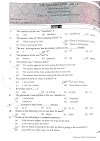Types of Galvanometer
Works by using a compass needle to compare the magnetic field generated by an unknown current to the magnetic field of the Earth (based on tangent law).
Deflection .
.
Smaller the K, larger the sensitivity.
Best method to increase sensitivity is to increase B.
It contains an insulated copper wire coil on a non-magnetic circular frame.
If is kept small accuracy decreases. Accuracy is maximum when
It used to measure the quantity of charge that is discharged through it.
Here,
Coil is wound over non-metallic frame.
It may be of the moving coil type or of the moving magnet type.
Moving Coil Galvanometer
A moving coil galvanometer is an instrument which is used to measure electric currents.
It is made up of a rectangular coil made of thinly insulated or fine copper wire that is wounded on a metallic frame.
A phosphor-bronze strip that is connected to a movable torsion head is used to suspend the coil in a uniform radial magnetic field.
: When a current-carrying coil is placed in an external magnetic field experiences magnetic torque. The angle of deflection is proportional to the magnitude of current in the coil.
i.e. or
where, is a galvanometer constant.
:
Area of moving coil should be large.
Number of turns in the coil should be increased but up to certain limits as resistance also increases with increasing turns.
B should be large, for this laminated ‘ferro-cobalt’ steel permanent magnet is used.
Torsional torque per unit twist C should be made small.
:
It is the deflection produced in the galvanometer per unit current.
∴
It’s unit is or .
Current sensitivity can be increased by increasing and by decreasing C.
:
It is the deflection produced in the galvanometer per unit voltage.
∴
It’s unit is or .
Current sensitivity can be increased by increasing and by decreasingC,R.
Uses of Galvanometer
They are used for positioning and control systems.
They are also used in laser engraving, laser sintering, laser TVs, laser displays, etc.
They are also used for controlling the head positioning servos in the hard drives and CD/DVD players.
The galvanometer can be used to measure:
Ammeter: (Ammeter in the circuit by connecting it in parallel to low resistance called shut.
Voltmeter: Voltage by connecting it in series with high resistance.
Ammeter
In the given circuit
G - Galvanometer coil resistance
I – Total current passing through the circuit
– Total current passing through the galvanometer which corresponds to full-scale reading
S – Shunt resistance
In parallel, (Voltage across shunt=Voltage across galvanometer coil)
or,
or,
Shunt(S)
Final equivalent resistance
It is connected in series with the circuit to avoid the division of current.
When it’s is connected in series it increases the resistance and decreases current.
So, ideal ammeter has zero resistance.
The range of ammeter can be increased but cannot be decreased.
The ammeter of lower range has higher resistance.
i.e. Microammeter > Milliammeter > Ammeter
If a galvanometer is converted into a multi range ammeter then,
Range of ammeter Resistance of ammeter=const.
An ammeter has resistance of G and range of I amp, then resistance connected parallel to converted it into ammeter of range amp. is .
If a galvanometer of resistance G is shunted by resistance of S.Then resistance required to be added in series to maintain constant initial main current in the circuit is .
Voltmeter
In the given circuit
R = Value of high resistance
G = Galvanometer coil resistance
= Total current passing through the galvanometer which corresponds to a full-scale deflection.
V = Voltage drop across galvanometer and high resistance.
When current passes through the series combination of the galvanometer and the high resistanceR; the voltage drop across the branch ab is given by
∴
Resistance of voltmeter formed.
It is connected in parallel with the circuit.
The resistance of an ideal voltmeter is infinity.
The range of voltmeter can be increases and decreased.
An electrometer is used to measure the p.d very accurately as it does not draw any current and is an ideal voltmeter.
The voltmeter of lower range has lower resistance.
i.e. Voltmeter > Millivolt meter > Micro voltmeter
A galvanometer can be converted into certain range ,V by using suitable resistance, R in the series with the galvanometer given by,
To convert into voltmeter of range V into range of , resistance that should be connected in series is .
Total resistance of combination, .









0 Comments